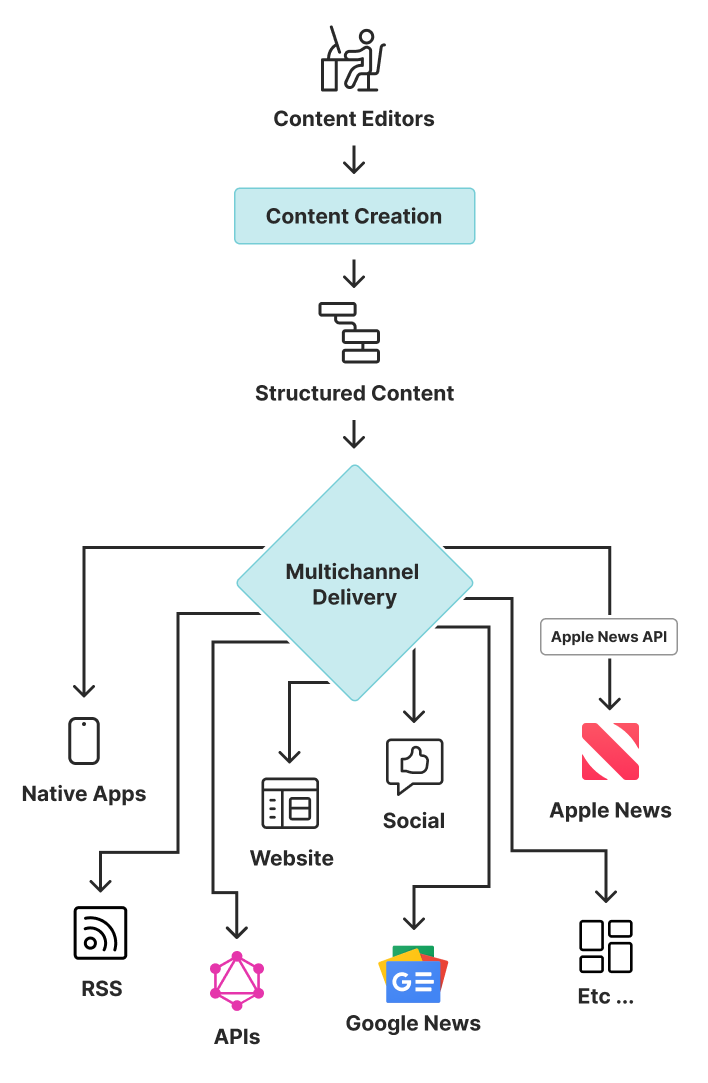Whether you are a publisher or marketer, content is pivotal to your role. It either is your product or your product’s success depends on it. But generating the engaging content your brand requires is only half of your challenge. In the end, that effort is all for naught if nobody sees your content.
Delivering content to your audience where, when, and how they want it is the remaining half of your challenge. To say that managing and delivering content effectively, efficiently, and strategically is complicated — especially for publishers that live or die by earned ads revenue — is somewhat of an understatement.
Suppose you own the marketing technology efforts or website leadership for your brand. In that case, you already know how critical delivering a diverse mix of content and digital assets to the right audience at the right time is. You also understand the difficulty of storing and distributing digital assets custom coded for each channel’s publication requirements. You need the right tool for the task.
What you need is a multichannel distribution content management system (CMS).
What is a multichannel distribution CMS?
A multichannel distribution CMS, also known as a multichannel or omnichannel CMS, is a content management system with the backend capability to automatically and appropriately distribute content across various channels and platforms.
One of the defining features of a multichannel CMS is that it separates where content is designed, created, and stored from where it is presented to the end user. It also keeps your content building blocks – text, image, graphics, multimedia, music, podcasts, video, search/field functions, and more — categorized and organized in the same place. This allows various configurations of those elements to be retrieved from a single source and delivered via APIs to meet the requirements of any channel’s platform. Drawn as a process chart, a multichannel CMS looks like this:

The model of a multichannel distribution CMS operates on a one-to-many relational concept. From a single source, you can distribute your content anytime, anywhere simultaneously. You can also set publication schedules across each channel, ensuring timely delivery.
But that’s not the only reason to love multichannel content management systems. These content-publishing workhorses offer quite a few additional benefits.
5 Benefits of publishing content with a multichannel distribution CMS
1. You’re no longer running just to keep up
By using a multichannel delivery CMS, you no longer carry the burden of crafting content to meet specific channel requirements, juggling multiple channel user credentials, and manually entering your content for distribution.
For years, web developers and content creators have been devising piecemeal publishing solutions as new channels emerge and are adopted by content consumers. However, content publication channels proliferate far faster than piecemeal processes. Consider some of the most commonly owned channels: desktop web, mobile web, Android apps, iOS apps, eCommerce platforms, IoT interfaces, and print. That’s seven unique outputs required before even factoring in formatting for the many device types those channels may land on.
A multichannel distribution CMS eliminates this burden. It allows creators to focus on developing better content instead of just chasing code.
2. Newfound agility and flexibility
A multichannel CMS also means you can adopt new channels more quickly and easily. The building-block nature of this kind of CMS makes it easy to connect a new channel to the rest of your ecosystem without worrying about how it might impact your other technologies or channels.
3. Future-proof your business
Traditional, monolithic CMSs that tether content to functionality eventually forces you to use “Frankenstein” workarounds to achieve all your publication goals. This creates bottlenecks and precarious workflows. Not to mention that if key employees who know the ins and outs of these system quirks leave your company, they take their knowledge with them, leaving new developers scrambling. Organizations often spend significant budgets and resources maintaining an old status quo that no longer meets the demands of efficient and consistent omnichannel content delivery.
A modern, multichannel distribution CMS is flexible. It can be integrated with — and built on top of — nearly any stack for use with any device, channel, or technology. This future-proofs your content publication processes and empowers you to scale your delivery infinitely across channels.
4. Speed up campaign deployment
A multichannel delivery CMS immediately provides your relevant content to your audiences where they are most likely to find and use it. It speeds up the time to implement campaigns because you don’t have to manually make changes across different systems, de-structure content, or re-architect content. Because a multichannel CMS presents a single, centralized content hub, you simply apply your campaign to whichever channels and devices you choose. This type of deployment is smoother and quicker, accelerating your time-to-market.
5. Earn more revenue
Whether directly or indirectly, the role of content is ultimately to create revenue or reduce cost. You achieve both when content becomes faster to produce and deploy and easier for your audience to consume on the channels they choose.
Because you can easily add new channels into the distribution process of your multichannel distribution CMS, you can reach new audiences and capture the unique revenue advantages some distribution channels offer.
For example, by adding Apple News as a new distribution channel to other web-based channels, brands have significantly increased their revenue. Interactive and engaging articles are easily converted by the multichannel delivery CMS, which configures them to Apple News Format and then delivers them directly through the Apple News API to the 1.8 billion Apple devices being used in the market today. This approach protects your brand from recurring infrastructure costs that typically increase linearly with traffic because Apple News serves the content directly from its infrastructure.
It’s time for a multichannel CMS
Your business depends on — and is driven by — content publication, flow, access, security, and regulation. Getting your content into the hands of the right users in the right way maximizes your content’s value and impact. You accelerate your success when you can centrally manage your content, readily control how and where it is used, and select the channels for its release.
Content output options will only continue to increase as digital technology continually transforms. It’s time for marketers and large-scale publishers intent on maintaining their competitive edge to meet this future with a multichannel distribution CMS.



